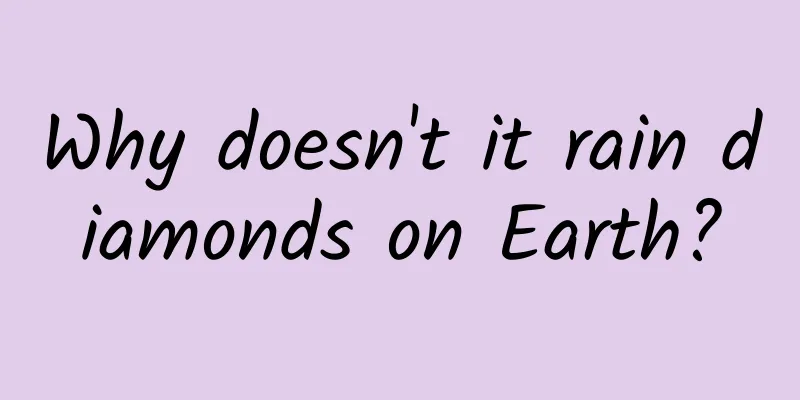Why doesn't it rain diamonds on Earth?

|
Recently, a US scientific research team inferred through simulated scenario experiments that diamond rain will fall over Saturn, Jupiter and many planets outside the solar system. This is another breakthrough following the research theory that "diamond rain often falls over Uranus and Neptune in the solar system." Scarcity makes things valuable. As one of the most expensive items on earth, diamonds are loved by people because of their brilliance, hardness and small quantity. Diamond rings made of diamonds are the main gifts for marriage proposals. Diamond rain falls on Uranus, Neptune, Saturn, Jupiter, etc. Why doesn't it fall on Earth? Can the diamond rain scene simulated in the laboratory be promoted and applied? High-end diamonds, source: Diamond Trading Network 01. Unusual rain! The rain we imagine is naturally the "water" from the sky falling down. In fact, this is just a special scene on Earth. As we all know, water on the ground turns into water vapor (also called "water vapor") when it is exposed to sunlight. The water vapor rises into the air and turns into small water droplets when it encounters cold air. These small water droplets have two fates: small and light ones are held in the air by air currents and become clouds; slightly larger ones, after aggregation, gravity exceeds the buoyancy of the air and become raindrops that fall to the ground. If slightly larger raindrops encounter a sharp drop in temperature, they will condense into hail and fall. From this we can see that rain is a physical change. Schematic diagram of rain and snow formation, source: Online Classroom Network Diamond rain is fundamentally different from rain on Earth. According to data from the probes that flew over Uranus in 1986 and Neptune in 1989, and scientists' experiments to simulate the process of reducing diamond rain, lightning over the planets decomposes methane in the gas, forming carbon in the form of soot, which falls to graphite, and the graphite falls to the depths of the planet and forms diamonds due to the huge pressure. The process from methane to carbon to graphite to diamond is clearly a chemical change. Crystal clear diamonds and black carbon powder and graphite are from the same family. Source: Diamond Trading Network Further analysis revealed that diamond rain mainly depends on two conditions . First, there is a certain amount of methane in the sky. At the end of the last century, Western scientists discovered that under certain temperature and pressure conditions, methane will decompose to produce carbon atoms, which will eventually aggregate to form diamonds. Among the four gas planets in the solar system, Uranus and Neptune do not have rocks and soil like the Earth, but are covered with atmospheres composed of gases such as hydrogen, helium, methane, and ethane. Scientists once believed that since methane accounts for about 15% of the total gas, the conditions for diamond rain are completely met over them; the methane content over Saturn and Jupiter is very low, less than 0.5% of the total gas, so diamond rain will not occur. Recently, a US research team has concluded that not only is diamond raining over Saturn and Jupiter, but about 1,000,000 kg of carbon falls into the depths of the planets every day and turns into diamonds, which is 50 times the annual diamond stock on Earth. The largest of these diamond "rains" is more than 1 cm in diameter, similar to large diamonds of about 15 carats. Secondly, there must be special natural phenomena or conditions , such as strong lightning, ultra-high temperatures, ultra-high pressures, and an ultra-thick atmosphere or mantle. In addition to lightning storms with ten strikes per second, temperatures of several thousand degrees, and pressures of millions of Pa, an ultra-thick atmosphere or mantle provides an excellent place for methane to turn into diamonds. Take Saturn and Jupiter as examples. It is speculated that their atmospheres are tens of thousands of kilometers long, while the Earth's atmosphere is only about 100 kilometers long. Their diameters exceed 120,000 kilometers, which is more than 10 times the diameter of the Earth. The thickness of their mantles can be imagined. After being struck by strong lightning over Saturn and Jupiter, methane descends more than 4,000 kilometers and turns into graphite. Graphite descends more than 6,000 kilometers to the surface of the planet and turns into diamonds due to strong pressure. Diamonds cross the mantle of more than 10,000 kilometers to reach the core of the star, and the ultra-high temperature turns them into liquid, forming a veritable "diamond sea". Neptune structure diagram, from outside to inside, upper atmosphere, lower atmosphere, mantle, and core. See watermark for source 02. The invisible diamond rain! As the only celestial body known to mankind that breeds and supports life, diamond rain has never occurred and will never occur on Earth. First, the methane content on Earth accounts for 0.0002% of the total gas. Even if all of it is converted into diamonds, it is only one thousandth of the number of diamonds on Saturn. Second, the atmospheric pressure on Earth is far from enough to turn methane into diamonds. The atmospheric pressure required to complete this operation is enough to crush a mountain into powder, not to mention the human body. Third, even if we take a step back and complete the operation of turning methane into diamonds above the earth, due to the high falling speed and sharp jagged edges, the surface of the earth will be damaged beyond imagination, and the consequences will be unimaginable. Simulated diamond rain, source: Zhuyouhanxing blog Diamonds won't rain from the sky, but is it possible to produce diamonds in bulk through experiments, as the American scientific research team did before? The answer is no. This is because the experiment not only requires extremely expensive and complex equipment, but also the technical difficulty of simulating the internal environment of the planet is very high. The difficulty is mainly reflected in lightning, high temperature, pressure and other aspects. The intensity of lightning is not ordinary. The water vapor in the atmosphere above the gaseous planet, affected by the heat inside the planet, will gather to form thunderstorm clouds, which will then produce lightning. It is estimated that the intensity of lightning on Jupiter is 1,000 times that of lightning on Earth, with a frequency of nearly 10 times per second. Currently, humans can only conduct extremely small-scale tests on ultra-strong lightning. Violent lightning on Jupiter, source: NASA, from the Juno probe The temperature required to decompose the substance is quite high. To decompose methane or methane-like gases (such as polystyrene) and obtain the carbon element in them, the temperature must be raised to 5000 degrees Celsius. When the experiment reached this temperature, only a very small amount of methane was decomposed. The pressure is ridiculously high. The experiment required 1.5 million Pa to turn graphite into diamond. 1 Pa refers to the pressure intensity when 1 Newton of force is evenly pressed on an area of 1 square meter. In the words of Klaus, a member of the American research team simulating diamond rain, "(the pressure that turns graphite into diamond) is equivalent to the pressure generated by the weight of about 250 African elephants concentrated on the surface of the thumb nail. This may also be the environment 10,000 kilometers below the surface of gaseous planets such as Neptune." It is known that the cost and difficulty of extracting diamonds from methane or methane-like gases are unimaginable. Some people have estimated that to extract 1 carat of diamonds from methane, at least 1,000 carats of diamonds must be purchased. There is no way to obtain diamonds from planets like Uranus, and it is impossible to expect diamond rain on Earth. Producing diamonds from methane is not worth the effort, so the topic of diamond rain can only be used as a topic of conversation after dinner, or as material for writers to create science fiction novels! References: 1. Paper "Scientists successfully created "diamond rain", "Zhangqiao Science and Technology", 2017 2. Paper "Surface Analysis of the Eight Planets in the Solar System", Science and Life, Issue 20, 2011 3. Article "Scientists speculate: The phenomenon of "diamond rain" in the universe is very common", Shepherd Astronomy Forum 2022.9.14, author Xie Renjiang END Author: Wei Deyong, member of Shenzhen Writers Association, Guangdong Reviewer: Lu Yangxiaoyi, PhD in Planetary Physics, Member of the Chinese Astronomical Society Editor: Guru |
Recommend
Two major benefits of frequent mergers between the top two in the Internet industry
Judging from the four O2O mergers that occurred t...
It takes hundreds of tools to operate and plan an event!
When I first started operating , I was completely...
How much does it cost to produce the Changji Dry Goods Mini Program? Changji dry goods applet production price inquiry
There is no fixed price for the production of the...
Strategy for building an APP user incentive system
In product operation, the user incentive system i...
Can egg yolk oil be used to treat children's eczema and diaper rash?
gossip “Egg yolk oil can be used to treat eczema ...
This habit is very harmful to the brain, but many people cultivate it as a virtue. It is recommended to change it immediately!
In the TV series The Return of the Condor Heroes,...
How to achieve user growth from the perspective of user retention goals?
Retention is the goal of many product operations ...
Earthlings have been working hard to find extraterrestrial civilizations
Recently, many media outlets have reported that t...
User observation on how one-year-old babies use mobile devices
There is a principle called "predetermined u...
Android phone "runs Stable Diffusion" and sets a new record, producing images within 15 seconds
As we know, Stable Diffusion is a very popular te...
How much does it cost to develop a mini program for Hegang Dance School? Hegang Dance School Mini Program Development Price Inquiry
Mini programs provide convenience for publicity a...
Inphi appoints marketing and public relations general manager in China
Recently, Infiniti announced the latest personnel...
Social media operations: attracting new members, retaining members, and converting members
We have talked a lot about methods and strategies...
What! We won't be able to drink Coke in half a year?
On a hot summer day, opening a bottle of ice-cold...
What are the functions of the Zhongshan education and training institution mini program? How much does it cost to develop a small program for educational institution management?
We are actively pursuing our careers to the next ...









